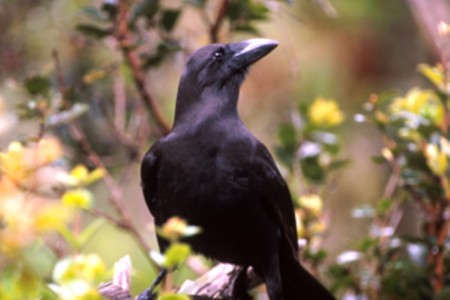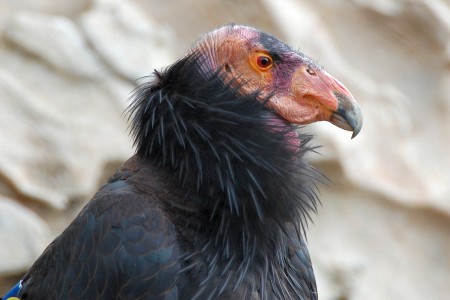

Staghorn Coral
A Coral Species on the Edge of Extinction

INTRODUCTION
Staghorn corals (Acropora cervicornis) are typically found in clear, shallow waters, such as those in the Bahamas, Florida, the Caribbean, Puerto Rico, and the U.S. Virgin Islands. For the last 5,000 years, they have been one of the most important reef-building corals in the Caribbean. They are golden tan or pale brown, with white tips and an antler-like shape.
• Kingdom: Animalia
• Lifespan: up to hundreds of years
• Diet: photosynthetic algae, plankton
• Habitat type: Marine Neritic
• Length: 4 feet in height and up to 6-8 feet in diameter. Healthy corals can grow up to 8 inches of new branch length in a single year.

Staghorn corals range. Data in the box: NOAA Fisheries
Staghorn colonies, known as “thickets,” provide critical, safe habitats for various marine creatures and are a vital part of the ocean ecosystems, providing essential services to coral reefs, other dependent species, and the protection of coastlines.
Water heated by climate change and acids derived from CO2 emissions, disease, habitat degradation, pollution, predation, and overfishing are killing vast numbers of staghorn corals, and their population continues to decrease precipitously. Last assessed in 2021, they were listed as Critically Endangered Species by the IUCN Red List.
THREATS TO STAGHORN CORALS

According to the National Ocean and Atmospheric Administration (NOAA), staghorn coral populations have declined by as much as 97% since the 1980s. Negatively and lethally affected, staghorn corals fall prey to various factors, including climate change, pollution, and overfishing, making them one of the most threatened coral species in the world. Recent successes have been restoring staghorn coral populations through outplanting and larval propagation methods. However, the species continues to be listed as threatened under the Endangered Species Act (ESA).
Global climate change
Warmer temperatures caused by climate change melt freshwater frozen as glaciers and other forms, resulting in rising sea levels. Since corals need shallow, well-lit waters to thrive, deeper water makes it harder for them to get the sunlight they need. Storms also increase in intensity as climates warm, where even the healthiest reefs are damaged or destroyed. Changing climate also causes ocean acidification, impairing the corals’ calcification rates and ability to create and maintain a strong skeleton.
White band disease

Staghorn Coral affected by White-Band disease. Adona9, CC BY-SA 3.0, via Wikimedia Commons.
Of all the threats staghorn corals face, the one most responsible for the current devastation of the species is white band disease, a bacterial infection. While little is known of the pathogen that causes it, one known fact is that this is a very selective disease that attacks only staghorn and Elkhorn corals.
Predation

Spotfin lionfish (Pterois antennata) is an invasive species threatening the well-being of coral reefs and other marine ecosystems. Image by Vlad61/Depositphotos
As if white band disease was not enough of a threat, staghorn corals have several other natural predators that prey on soft, immature, and easily accessible coral polyps. Crabs, snails, marine worms, barnacles, sea stars, fish, and invasive lionfish take advantage of their vulnerability and consume them. Lionfish and crown-of-thorns starfish are the two most damaging predators of staghorn corals.

Crown-of-thorns starfish are eating staghorn coral. Image by Ead72/Depositphotos
The crown-of-thorns starfish is an especially voracious predator that causes extensive damage to coral reefs worldwide. After reaching outbreak levels, they can decimate entire reef systems. Traditional control methods, such as manual removal by divers, are time-consuming and labor-intensive and often ineffective when the reefs are overwhelmed.

Crown-of-thorns starfish (Acanthaster planci) is truly beautiful but a potent coral killer. Image by Vladimir Golubev/Depositphotos
Researchers have developed autonomous underwater vehicles (killer robots) designed to navigate and operate continuously in the complex underwater environment covering large reef areas to address this issue.
They work tirelessly, 24/7, without the limitations of human divers, and can access more profound and more remote parts of the reef that are difficult for divers to reach. Once a crown-of-thorns starfish is detected, the killer robots administer a lethal injection of bile salts or other chemicals to eliminate it without harming other marine life.
Bleaching

A large bed of bleached, dead, and dying coral. iStock.com/Rainer von Brandis
Coral bleaching occurs when the algae that live inside the coral expel themselves due to stress from the changing environment. Without these algae, the coral loses its primary food source and turns white. This is another problem related to climate change and ocean warming, bringing higher water temperatures to the staghorn coral populations. Warmer water temperatures weaken the corals, making them more susceptible to bleaching and other diseases. While bleached coral can sometimes recover, it is often too weak and vulnerable to diseases to survive.
Pollution
When present, and unfortunately, they are increasingly present in reef environments, pollutants can severely damage corals and other reef inhabitants. Deforestation, farm runoff, oil, and chemical releases all cause tremendous damage to staghorn coral, suppressing growth and curtailing reproduction. Many times, pollutants wipe out whole thickets of staghorn coral. As the development of coastal areas for residential and industrial uses increases, additional pollution and silting issues are descending on coral reefs.
Overfishing
When fishing on reefs occurs, herbivore fish often control the algae sought after, leaving algae to dominate while corals perish. Another terrible blow to corals is using fishing techniques such as bottom trawling and explosives. Harvesting fish using these methods damages corals and indiscriminately destroys other species.
IMPORTANCE OF STAGHORN CORALS

Staghorn corals are integral to maintaining healthy reef and ocean ecosystems, and their loss negatively impacts those systems. Their decline decreases the critical habitats they provide for marine species, including fish and other invertebrates that depend on them for shelter. It also leads to losing other dependent species in the food chain. These losses can devastate and extend into other ocean systems, such as fishing stocks.
Many people depend on fish and other seafood as primary food sources for employment in the fishing and tourism industries. The losses of these food sources increase food insecurity, while incomes also dry up, both of which drive migration. Boiled down, when there are no more reefs, there are far fewer tourists and not enough food to sustain people, with the result being many more migrants forced to be on the move. As can be seen, around the world, many migrants bring huge monetary and other costs.
Coral reefs, home to diverse marine life, including the fragile Staghorn Coral, serve as critical players in the Earth’s carbon cycle. As corals photosynthesize, they take in carbon dioxide and release oxygen, functioning as significant carbon sinks by absorbing copious amounts of carbon dioxide from the atmosphere. This absorption process not only aids in reducing the amount of this greenhouse gas in our atmosphere but also indirectly helps to combat climate change by offsetting some of the impacts of human carbon emissions. They effectively act as a natural buffer against the excessive greenhouse gases driving climate change.
They also play an important role in breaking up waves and protecting coastal communities from storm surges and erosion. When not present, coastal erosion increases, and it costs huge amounts to repair damaged infrastructure.
HOW TO HELP STAGHORN CORALS

Mitigating Climate Change and Advocating Political Will
Global climate change is an existential problem affecting all species, including the Staghorn Coral, and it is growing worse. The rising sea temperatures, increased ocean acidity, and more frequent severe weather events related to climate change put significant stress on the Staghorn Coral, leading to coral bleaching and a decline in overall health. Recent record-breaking ocean temperatures off the coast of Florida, which were over 100°F (38°C), only confirm that the planet is in trouble.
Central to mitigating the impacts of climate change is the engagement and commitment of political leaders. Policies that strive to reduce greenhouse gas emissions, invest in renewable energy, and promote sustainable practices in industries such as agriculture and manufacturing can profoundly affect combating climate change, and citizens have the power to demand these changes.
Voting for political leaders who recognize the urgency of the climate crisis and are willing to take decisive action is a critical step.
Make Sustainable Seafood Choices
Our choices at the dinner table can profoundly affect marine ecosystems like those inhabited by the Staghorn Coral. Overfishing and destructive fishing practices can upset the balance of marine life and lead to damaging chain reactions throughout the ecosystem.
When purchasing seafood, it is important to choose products caught or farmed in environmentally friendly ways. Overfishing and harmful fishing practices can decimate certain fish populations, disrupt the marine food chain, and adversely affect coral health. By opting for sustainably sourced seafood, consumers can help maintain the balance of marine life and support the habitats where Staghorn Coral thrives.
Several certifications and labeling schemes, such as Marine Stewardship Council Certified or Aquaculture Stewardship Council Certified, show that products gathered through sustainable fishing and farming can help you make responsible choices. In some regions, seafood watch programs provide up-to-date consumer guides on sustainable seafood options.
Civic Participation and Enlightenment
Individuals living near the coral reefs have a fundamental role in conservation initiatives. Educational schemes enlightening locals about the ecological importance of the Staghorn Coral, the perils it encounters, and how protecting this species also benefits their community are needed if locals aren’t aware of these issues. Educational programs and workshops can cultivate and intensify a sense of stewardship and engagement. When people know the problems, their efforts significantly influence coral conservation.
Promoting Responsible Ecotourism
Responsible ecotourism can aid the Staghorn Coral’s survival and conservation and provide monetary benefits to the local communities. When tourists choose eco-friendly tours emphasizing respect for local ecosystems and wildlife, they actively back conservation attempts. Tourism income, when conservation-centric, can increase local efforts to preserve and rejuvenate corals.
Fighting Unlawful Wildlife Trade
The unlawful wildlife trade doesn’t pose as significant a threat to the Staghorn Coral as it once did. Nonetheless, not purchasing wildlife unlawfully, especially endangered species like the Staghorn Coral, can help defeat this trade in other species. Advocating for more stringent laws and harsher punishments against wildlife smuggling can be a vital move toward protection.
Backing Conservation Organizations
Multiple non-profit bodies are advancing the Staghorn Coral conservation cause. The Coral Restoration Foundation in Florida is actively involved in several strategies, including habitat safeguarding, captive breeding, and reintroducing healthy individuals back into the wild. Apart from direct intervention, the organization also heavily focuses on raising public awareness about the plight of Staghorn Coral. You can significantly ensure this distinct species’ survival by supporting these initiatives through volunteer work, financial contributions, or spreading awareness within your circles.
Valuing Biodiversity and Participating in Citizen Science Initiatives
Recognizing species interdependence is crucial for conservation. The decline of the Staghorn Coral doesn’t solely impact the species but also its ecosystem, affecting others, including ours. By studying global biodiversity and each species’ role in maintaining ecosystem equilibrium, individuals can comprehend the urgent need for conservation.
Participation in citizen science initiatives aiming to monitor and protect biodiversity can offer valuable data to researchers. This information can help track population changes in species like the Staghorn Coral and steer future conservation efforts.
Final Thoughts
Safeguarding Staghorn Coral requires a united effort, from heightening community awareness and endorsing sustainable tourism to minimizing our environmental impact and advocating for effective legislation. Real results will be achieved only when leadership is on board with protecting the planet. Our job is to elect those persons and actively participate in initiatives contributing to the Staghorn Coral’s survival and the broader aim of preserving our planet’s distinctive biodiversity and livability.












